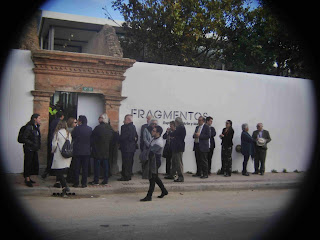 |
| During the exhibition's inauguration, the artsy wait in line to visit empty rooms. |
 |
| The floor is the work of art. Appreciate it! |
For the memorial site, organizers found a centuries-old house whose adobe walls and columns have
slowly crumbled away in the rain and wind. Interestingly, they preserved the ancient house's remains, which itself seems like a haunting reflection on Colombia's long tragedy.
 |
| Melting down FARC weapons. |
Feeling cheated - even tho entrance is free - I asked other visitors why Salcedo's promised artwork memorializing the victims was not to be found. They looked down: "The artwork is the floor," one told me.
In fact, Salcedo had used the tons of metal from the melted guns and other weapons to make the exhibition hall's floor. Her idea was to create a 'counter-monument,' an exhibition guide told me. A 'counter-monument' does not project the sorts of preconceptions which a regular monument would, she explained.
That's all well and good. And it's also true that making the weapons into a floor carries symbolisms -
 |
| The old building's eroding adobe makes an interesting backdrop. |
But I suspect that an unsophisticated peasant from Santander, El Chocó or Putumayo whose relatives had been tortured, disappeared and driven from their homes by armed groups, and who herself had been violated, might not appreciate these lofty, abstract artistic sentiments. She'd look for a concrete representation of Colombia's tragedy.
Colombia, it seems to me, needs something like Washington D.C.'s low, haunting, Vietnam Memorial, or Berlin's headstones commemorating the victims of the Nazi Holocaust.
But maybe not yet. After all, Colombia's conflict is still unresolved. A substantial proportion of the FARC's fighters refused to demobilize and are considered 'dissidents.' And the ELN and myriad narco-gangs and other groups remain out there causing havoc and violence.
Colombia's violence, sadly, is far from over.
The FARC's weapons and the United States:
Notably, some of the FARC's newest and most potent weapons had been purchased in the United States - the same nation which has spent billions of dollars trying to defeat Colombia's leftist insurgencies. Similar to Colombia's illegal drug industry, which the U.S. both combats and finances, the U.S. is on both sides of the guerrillas weapons-wise: it pays the Colombian government to battle the guerrillas, while supplying those same guerrillas with weapons to fight the government and terrorize civilians.
By Mike Ceaser, of Bogotá Bike Tours


















































